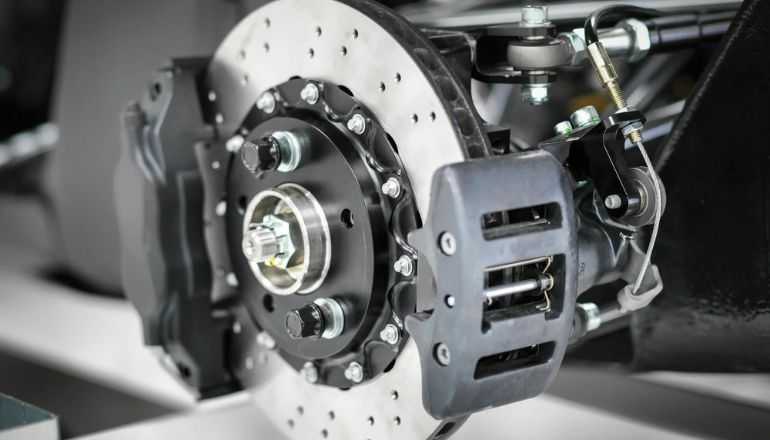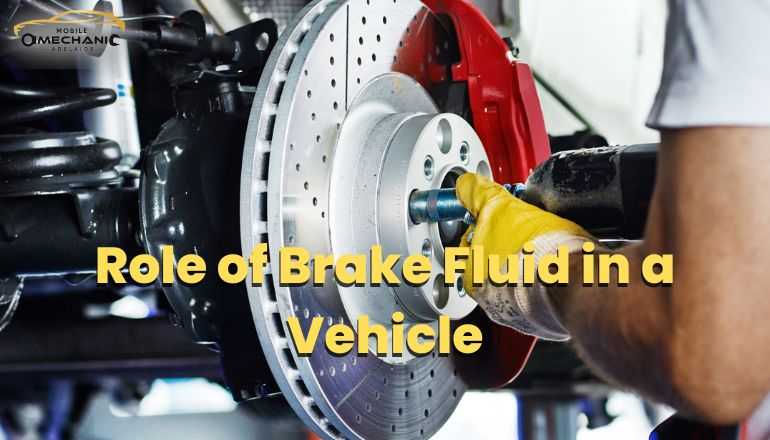Brake fluid is a vital component in a vehicle’s braking system, playing a crucial role in ensuring safe and reliable braking performance. The brake system works by converting the mechanical force applied by the driver on the brake pedal into hydraulic pressure, which in turn applies force on the brake pads or shoes and ultimately slows down or stops the vehicle. Brake fluid is the medium that enables this hydraulic pressure transfer between the brake pedal and the brake calliper or drum.
Brake fluid is a type of hydraulic fluid specifically designed to withstand the high temperatures and pressures generated in the braking system. It is typically made of glycol-ether, silicone or mineral oil and contains additives that provide lubrication and prevent corrosion and oxidation of the metal brake components.
The brake fluid is stored in a brake fluid reservoir, also called the master cylinder, connected to the brake pedal via a rod or linkage. When the brake pedal is depressed, the master cylinder piston is pushed, creating pressure in the brake fluid. This pressure is then transmitted through the brake lines to the brake callipers, which in turn apply pressure on the brake pads. This pressure causes the brake pads or shoes to grip the brake rotor or drum, creating friction and slowing down the vehicle.
Over time, brake fluid can become contaminated with moisture, dirt, and other debris, degrading its performance and compromising the braking system’s safety. This is when you must consult a 24 hour mobile mechanic Adelaide and get the brake fluid replaced immediately. Replacing the brake fluid must be an essential part of the vehicle’s regular maintenance schedule.
Another important property of brake fluid is its ability to maintain a consistent viscosity or thickness, even under extreme temperature conditions.
This is important because as the brake system heats up during use, the brake fluid can also heat up, causing it to expand and potentially lose its effectiveness.
Conversely, the brake fluid can thicken in cold weather conditions, making it harder to transmit hydraulic pressure and slowing down the braking response. Such situations require brake fluid replacement so that the fluid has a specific viscosity rating to ensure it functions correctly under various temperature conditions.
It is also essential to use the best brake fluid for your vehicle’s braking system, as different types of brake fluids have different properties and may not be compatible with each other. Using the wrong type of brake fluid can cause damage to the brake system and compromise the safety of the vehicle.
Brakes play a critical role in ensuring the safe and reliable operation of a vehicle’s braking system. Proper maintenance and replacement of the brake fluid can help prevent bleeding brakes, improve braking performance, and ensure the safety of the driver and passengers.
What is Brake Fluid?
Brake fluid is a specialized hydraulic fluid used in a vehicle’s braking system. It is an essential component that enables force transfer from the brake pedal to the brakes, allowing the driver to slow down or stop the vehicle. The best Brake fluid is designed to withstand the high temperatures and pressures generated by the braking system and provide lubrication and protection against corrosion.
Brake fluid is typically made of a mixture of glycol-ether, silicone, or mineral oil, along with additives that improve its performance and protect the metal components of the braking system. The composition and properties of brake fluid depend on the specific application and the type of vehicle.
A vehicle’s braking system consists of several components, including the brake pedal, brake lines, brake callipers or wheel cylinders, and brake pads or shoes. When the driver presses the brake pedal, a piston in the master cylinder compresses the brake fluid, creating hydraulic pressure that is transmitted through the brake lines to the brake callipers or wheel cylinders. This hydraulic pressure then causes the brake pads to press against the brake rotor or drum, creating friction and slowing down or stopping the vehicle.
It is essential to maintain the proper level of brake fluid and to replace it periodically as recommended by the vehicle manufacturer, to ensure the safe and reliable operation of the braking system. Brake fluid is stored in the master cylinder, which is typically located near the brake pedal. The brake fluid reservoir allows the brake fluid level to be monitored and refilled as needed.
Key Features of Braking Fluid

Several key features of brake fluid are important to understand to ensure the safe and effective operation of a vehicle’s braking system:
1. High Boiling Point
Brake fluid is designed to have a high boiling point, typically above 400 degrees Fahrenheit, to prevent it from vaporizing or boiling in the high temperatures generated by the braking system. If the brake fluid boils, it can create gas bubbles in the brake lines, reducing hydraulic pressure and compromising the effectiveness of the brakes.
2. Low Compressibility
Brake fluid is designed to be non-compressible, meaning that it does not compress or expand under pressure. This allows the hydraulic pressure generated by the brake pedal to be transmitted directly to the brakes, ensuring a rapid and effective response.
3. Corrosion Protection
Brake fluid contains additives that protect the metal components of the braking system from corrosion and wear. This is particularly important in areas with high humidity or exposure to saltwater, which can cause rust and corrosion.
4. Viscosity Stability
Brake fluid is designed to maintain a consistent viscosity or thickness, even under a range of temperature conditions. This ensures that proper brake fluid is flush, regardless of the temperature of the brake fluid.
5. Compatibility
It is important to use the correct type of brake fluid for your vehicle’s braking system, as different types of brake fluids have different properties and may not be compatible with each other. Using a brake fluid tester can prevent you from using the wrong type of fluid, thus preventing damage to the braking system and ensuring the vehicle’s safety.
Role of Brake Fluids in the Car
The role of brake fluid in a car is to enable the transfer of force from the brake pedal to the brakes, allowing the driver to slow down or stop the vehicle. When the driver presses the brake pedal, a piston in the master cylinder compresses the brake fluid, creating hydraulic pressure that is transmitted through the brake lines to the brake callipers or wheel cylinders. This hydraulic pressure then causes the brake pads or shoes to press against the brake rotor or drum, creating friction and slowing down or stopping the vehicle.
Brake fluid plays a critical role in operating a vehicle’s braking system. It must withstand the high temperatures and pressures generated by the braking system, as well as provide lubrication and protection against corrosion. Brake fluid is typically made of a mixture of glycol-ether, silicone, or mineral oil, along with additives that improve its performance and protect the metal components of the braking system.
Conclusion
Brake fluid is a crucial component of a vehicle’s braking system, allowing the driver to slow down or stop the vehicle safely. It must withstand high temperatures and pressures, as well as provide corrosion protection and lubrication. Understanding the key features of brake fluid, such as its high boiling point, low compressibility, corrosion protection, viscosity stability, and compatibility, is essential to ensure the safe and effective operation of the braking system. Consult a brake specialist in Adelaide for the proper maintenance and replacement of brake fluid, its continued effectiveness and the safety of the vehicle.
Brake fluid is a vital component of a vehicle’s braking system that enables the transfer of force from the brake pedal to the brakes, allowing the driver to slow down or stop the vehicle safely. This is essential to ensuring the effectiveness and safety of the braking system. Also, vehicle owners need to understand the key features of brake fluid to properly maintain and replace them when needed. Consult a mobile mechanic car service if you ever encounter a problem with the braking system.
